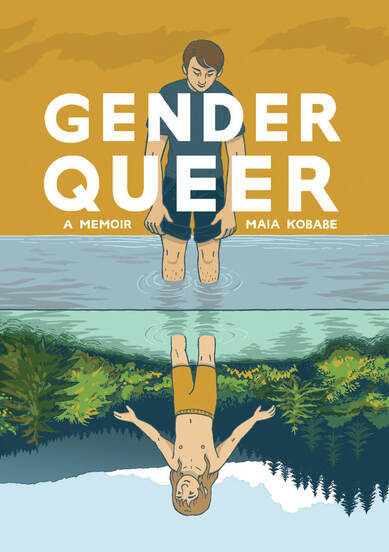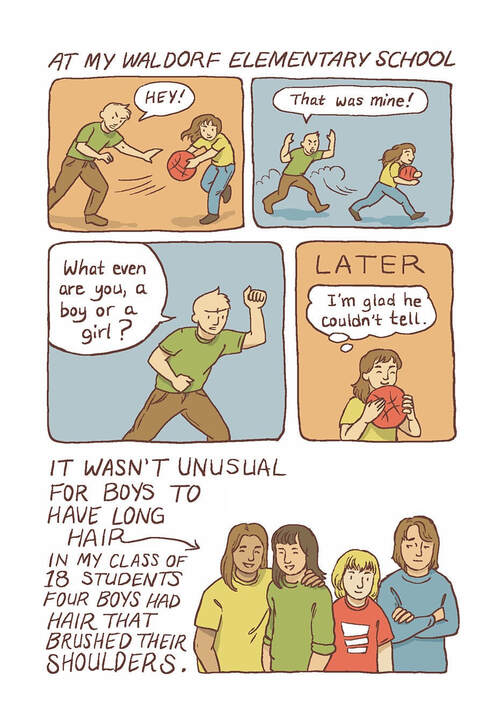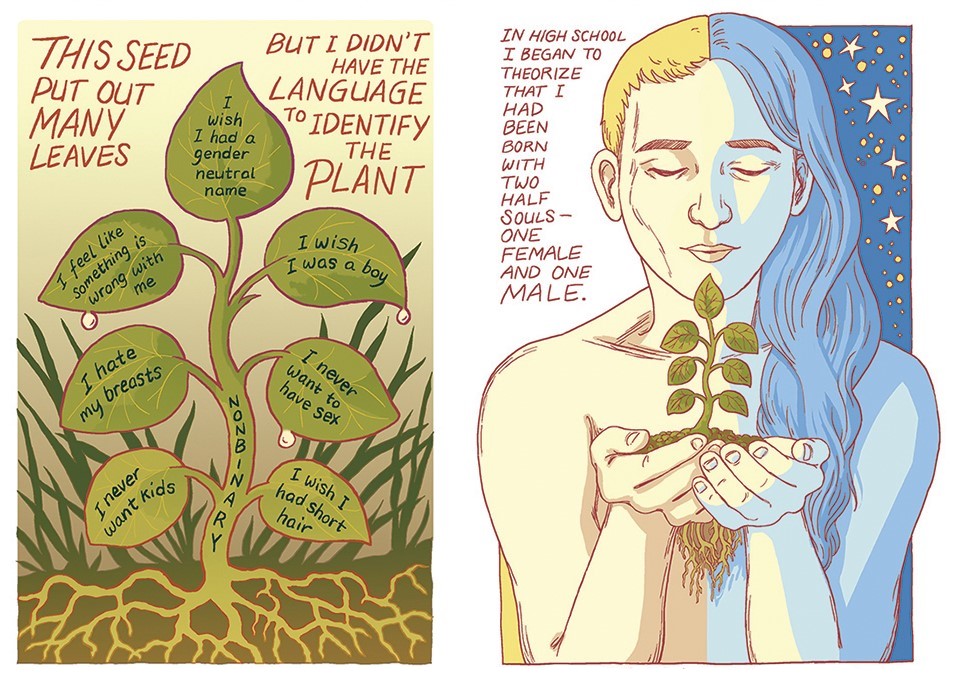|
Gender Queer. By Maia Kobabe. Colors by Phoebe Kobabe. Sensitivity read by Melanie Gillman. Oni Press, ISBN 978-1549304002 (softcover), May 2019. $17.99. 240 pages. Glad to get to this one, at last. Gender Queer bills itself (on its cover) as both a memoir and a guide. It does both well. As a memoir, it is intimate, recounting a personal story about the push-pull of body and mind, self and society. It is as candid as it must be, as discreet as it can be. This is Maia Kobabe’s story, told with autographic frankness. As a guide, it gestures beyond the personal, giving an authoritative (though not universalizing) perspective on gender dysphoria, asexuality, and the politics of being a nonbinary subject in a binary culture. Actually, it works well as a guide because it works as a story — meaning Gender Queer is authoritative because Kobabe lived it. The book demonstrates how comics, by interweaving picture, word, and symbol, can evoke the general through the particular; how graphic memoir can do the work of political as well as autobiographical witness. Gender Queer credibly witnesses to tough issues precisely because Kobabe does not assume that anyone else has lived with those issues in precisely the same way; that is, the book honors the specificities of eir life (Kobabe uses the Spivak pronouns e, eir, and em). The quirks of eir own experience make the book what it is—yet sharing those quirks brings a vivid honesty that will speak to readers whose circumstances are very different from the author’s. Gender Queer is bookended by scenes of teaching and learning. In the opening, Maia struggles with eir autobiographical cartooning class, taught by MariNaomi (part of eir Comics MFA at the California College of the Arts); e resists the idea of sharing eir “secrets” on the page. Overcoming that resistance is prerequisite to the very book we are reading, and Kobabe depicts eirself tearing away a kind of veil to share eir story with us. In the closing, Maia teaches eir own comics workshop to tweens and teens at a local library, but struggles again: e reproaches eirself for not coming out to eir students, that is, not sharing eir nonbinary identity and preferred pronouns. Oddly, then, this coming-out story ends with an instance of not coming out, and of self-blame. The book is open about troubles and misgivings of this sort, as well as the familial and social awkwardness of negotiating new pronouns. In one striking scene, Maia’s aunt, a lesbian and committed feminist, responds to the pronoun question by challenging Maia’s perspective on FTM transitioning and genderqueerness, suggesting that these things may stem from misogyny, from a “deeply internalized hatred of women” (195). Maia is troubled by this challenge, of course, but the scene plays out with a delicate touch (eir aunt is properly supportive, not an adversary). Thus Kobabe is able to field a sensitive question, perhaps even to defuse the likely skepticism of some readers. I confess that these admissions of awkwardness and trouble swayed me; it was good to see Kobabe dealing with the struggles of family and friends without rancor or caricature. Gender Queer is that kind of book: humanly complicated, and willing to lean into complexity and trouble (it pairs well with L. Nichols’s Flocks in that regard). As an autographic, testimonial comic, Gender Queer adds to the fund of helpful cultural resources available to queer and gender-nonconforming young people. At the same time, it testifies to how Kobabe has drawn upon cultural resources in eir own journey: books, comics, Waldorf schooling, homeschooling, and art teachers (two depicted here, MariNaomi and Melanie Gillman, are queer cartoonists themselves). In Maia’s quest for self-understanding, books loom large: e is a voracious and self-documenting reader, a lister of books read and re-read. Kobabe’s account suggests that storytellers such as Neil Gaiman, Tamora Pierce, and Clamp served eir as resources for self-fashioning. A now-poignant passage recounts how Maia, a delayed reader at age eleven, taught eirself to read so as to devour the Harry Potter books (the irony of which, at the present moment, cuts like a knife). At a key moment late in Gender Queer, Kobabe turns to another book, neurophilosopher Patricia Churchland’s Touching a Nerve: The Self as Brain (2013), and even conjures Churchland as a character, an expert witness whose testimony about “the masculinizing of the brain” affirms Maia’s sense that “I was born this way.” This flourish is perhaps a touch too triumphant: Kobabe gives no sense of the intellectual debate around Churchland’s ideas, but simply invokes her as a bookish authority and solution. In any case, Gender Queer is, through and through, the record of a reader’s life. Style-wise, Gender Queer favors spareness and economy. Scenic backgrounds are few, and deliberate; Kobabe’s panels often consist of head shots against color fields. Conversation, reflection, and expression are everything. Pages typically follow a grid, whether unvarying or, more often, a bit relaxed, letting the white of the page show through: On the other hand, Kobabe lets rapturous, full-page drawing take over every so often. Clearly, eir minimalism is a considered choice, as confirmed by certain passages that break with the general sparseness. Dig for example these two facing pages: Though Gender Queer is discursive and text-filled, it never feels clotted. Kobabe’s organic hand-lettering and use of unbordered elements give the art breathing room. The pages include telling pauses, open bleeds, and dialogic exchanges that add up to a accessible, even brisk, read. Disarming is a good word for Gender Queer: the book’s honesty about dysphoria and bodily phobias may trouble some readers. I myself started the book in, admittedly, a guarded or hard-hearted mood, skeptical of the family ethos depicted: the utopian, back-to-the-woods values, the homeschooling, every little thing that I could interpret as a sign of sheltering or self-indulgence. Of course I was being pigheaded, and wrong — as the book’s warmth and complexity so clearly showed me. Gender Queer is moving and informative, an invaluable memoir and guide.
0 Comments
Your comment will be posted after it is approved.
Leave a Reply. |
Archives
June 2024
|





 RSS Feed
RSS Feed
